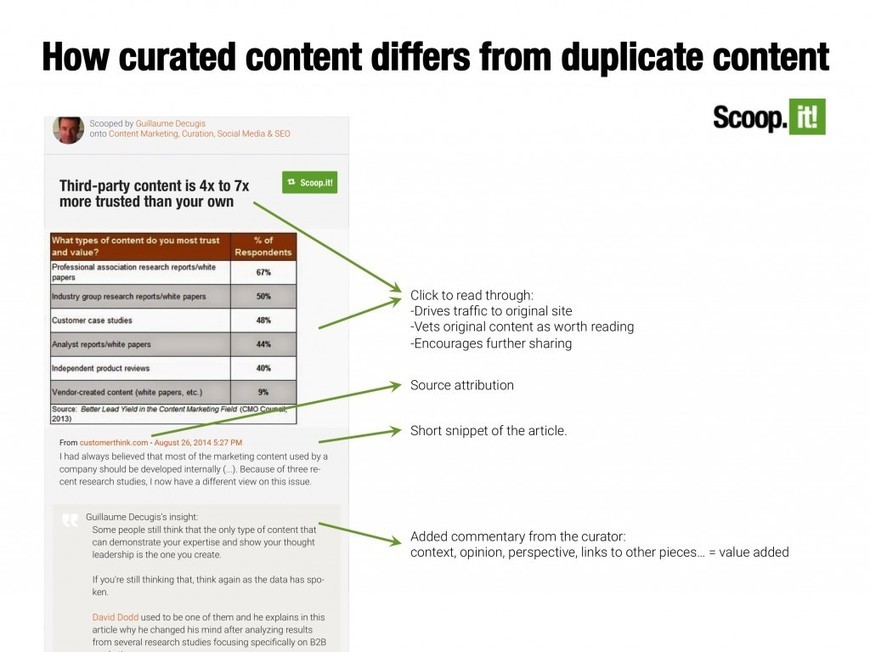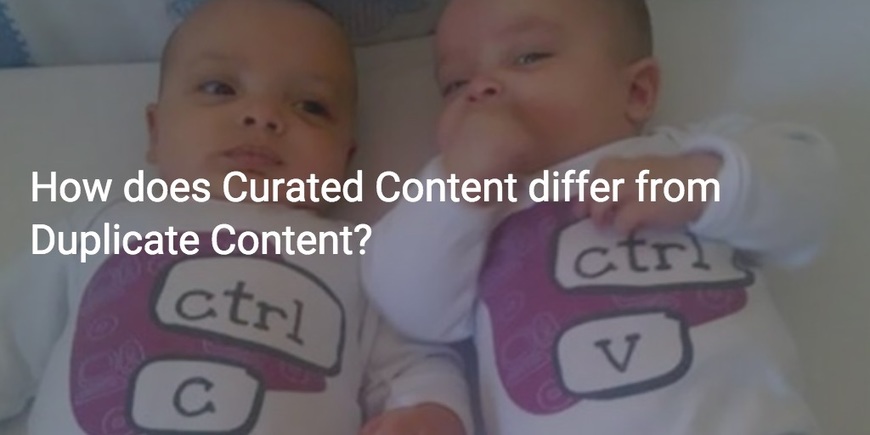Even though it’s been addressed by a lot of professional SEO experts, including Google’s Matt Cutts, this is still a question we get a lot. So let’s review it in detail what the difference is between curated content and duplicate content.
What is duplicate content?
Content is duplicated when similar content exists on 2 or more different URLs. This can happen on your own site with only original content if your Content Management System (CMS) isn’t configured in the right way and creates artificially new URLs for existing content. For instance if a blog post can be found through 2 different URL paths – something that can be addressed by using canonical URLS as explained by Google. Another example – this time across domains – is when you syndicate content as Google will see 2 or more exact same posts at different locations. For instance, if you have an industry website syndicate all of your content through its RSS feed or if you republish your own post on Medium or LinkedIn. Note that in both cases, we’re talking about duplicating a significant part or the entire content to another web page or to another site. It’s like saying: “I don’t care what this content is but it seems to work so let’s copy and paste it to our blog.” That’s not what content curation is as we’ll see below. But first, let’s look at why Google doesn’t like duplicate content and what it does with it.
Is duplicate content bad?
Not necessarily, says Google. As Matt Cutts explains: “It’s important to realize that if you look at content on the web, something like 25 or 30 percent of all of the web’s content is duplicate content. … People will quote a paragraph of a blog and then link to the blog, that sort of thing. So it’s not the case that every single time there’s duplicate content it’s spam.” Spam. That’s the important word here: the point Matt Cutts makes is that Google’s objective is NOT to prevent one website from quoting another one – a practice which has been going on since the invention of the World Wide Web and which is at its core through the hyperlink. But, he adds, “It’s certainly the case that if you do nothing but duplicate content, and you are doing in an abusive, deceptive, malicious, or a manipulative way, we do reserve the right to take action on spam.” So if you’re doing nothing but that (if you’ve automated the process without applying any curation) and you’re doing it to deceive Google, you’re in trouble. And should be. So Google recommends to syndicate carefully. In our own experience republishing to Medium, LinkedIn and other sites, we had great results in Google Search but we used different titles for each destination.
How is Content Curation different?
Though content discovery can be automated (and should be as it’s time consuming), Content Curators apply judgement before selecting what they publish. They also add context by adding value to their audience by telling them what it means for them. It’s like saying “Oh! I’ve read this piece of content and it’s really interesting for my prospects because it answers a question they often have in our commercial discussions.” Let’s make this visual through a slide of our guide of content curation benefits for SEO: 
Content Curation benefits for SEO
The above differences explain not only why content curation different than duplicate content but also how it helps bloggers, content marketers and great curators rank high in search results. Examples such as John Gruber’s Daring Fireball or Upworthy show that large audiences can be built relying 100% on curation with great, well-deserved results in Google search. To add data to these examples, the Bruce Clay experiment demonstrated how curated content with annotation ranked #1 for their target sentence. On the Scoop.it platform, we have data that goes beyond anecdotical evidence: Scoop.it traffic – which cumulates in hundreds of millions of visits – originates for about 40% from Google Search on average since we launched (and closer to 45% if we take the last 90 days). To follow up on this topic, here’s a little curation of other interesting reads from various SEO experts: – 3 Myths About Duplicate Content by Andy Crestodina on the Kiss Metrics blog. – 6 Facts About Content Curation You May Not Know by Jayson DeMers on the Scoop.it blog. – Google’s Matt Cutts: A Little Duplicate Content Won’t Hurt Your Rankings by Jennifer Slegg on Search Engine Watch
And if you’re interested in leveraging the benefits of content curation for SEO, check out our complete guide.




 (6 votes, average: 4.83 out of 5)
(6 votes, average: 4.83 out of 5)
Hi Guillaume,
Sitting here going over some business goals and objectives and doing a little research, when wham, I read your article. Perfect timing! Thank you Guillaume. I will have to read it a couple times more because of all the important points, and I will also have to recommend this to other curators for reference.
Very clear the explanation on the duplicate content. Had several questions in this regard but with this explanation remains me more than clear.
+1 Guillaume Decugis
You say that duplicate content is not always bad, but I have always suffered from the negative consequences of duplicate content and struggled to first find it around the web and then delete it or change my content somehow…
Jason, if you still grapple with duplicate content I recommend using http://copyact.com/ where you can actually save you website and allow the tool to crawl your content on a regular basis. You just need to provide your website address and will get reports on email any time a duplicate content is found. I protect multiple websites this way and assure you, it’s the most convenient way to search for duplicates.
Best,
Tim.
Yes. Business Insider or even the Huffington Post are also great examples. New media outlets are not producing 100% of their own content anymore so why should marketers?
As per Google’s Matt Cutts quote above, you could end up hurting your SEO by systematically using duplicated (not curated 😉 content. Occasionally doing it is not a problem but to be safe, use curated and not duplicated content.
Thank s for sharing